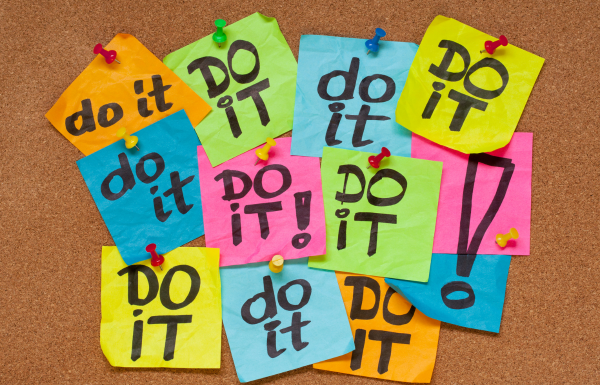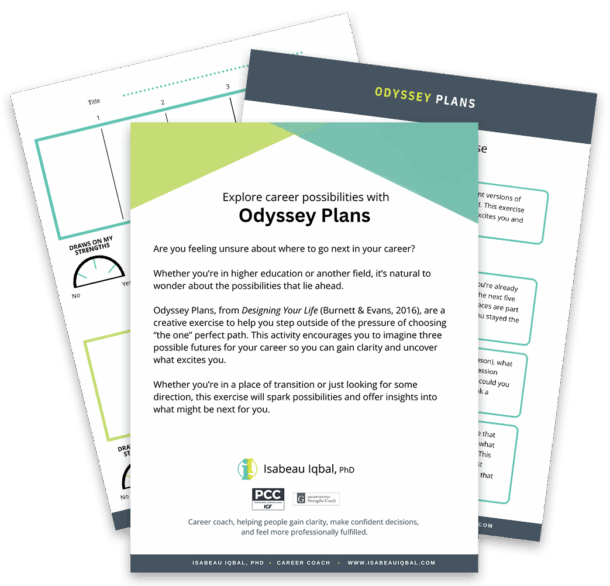By now, we’re past the wave of New Year posts about goals and words of the year. Don’t get me wrong—I love goals and intentions. But the beginning of January is a lot.
Still, there are probably some work tasks on your plate that you’d really like to move along. And yet…you don’t.
How do I stop putting off work?
Most of us have projects we avoid—writing that report, preparing a presentation, updating our resume. Sometimes we avoid them because they feel overwhelming or because we don’t know where to start. Other times, we avoid them even though we do know what to do.
In this post, I outline a strategy to help you get started (or keep going) on a work or career related project, when you aren’t “feeling it”.
Why do we procrastinate? (It’s not laziness)
Many people get incredibly frustrated with themselves when they can’t get going on work that they need to do and, in some version of themself, want to do.
Procrastination is very common among perfectionists and isn’t about being lazy. It’s about avoiding discomfort: stress, boredom, self-doubt, confusion etc. Ferrari (2023) defines it as intentional delay of a target task that prevents you from reaching your goal. The emotions we attach to completing the work are so present (even if we’re not consciously recognizing it) that it prevents us from starting or completing the work. Procrastination provides temporary relief but leads to worse outcomes later. (I’ve written a bit about this in the past)
These are some of the thoughts I have and emotions I experience when I am resisting a work task:
“This always takes forever.” (This will be a grind, and I resent doing it.)
“It’s so much work.” (I already feel exhausted just thinking about it.)
“This is hard.” (I don’t feel confident in my ability to do it well.)
“No one cares.” (I work so hard, and it feels unappreciated.)
Can you relate to any of these?
The strategy: ‘Duly Noted’
That’s where the ‘Duly Noted‘ strategy comes in. This approach, inspired by Dr. Hayden Finch, helps you acknowledge the emotions behind avoidance and choose a behaviour that directly counters procrastination. It brings in self-compassion (I’m a big fan) and is practical.
How to use “Duly Noted” to get started
Notice the avoidance: Pause and recognize that you’re delaying something because of discomfort.
1. Acknowledge your emotions: When resistance shows up, ask yourself: What am I feeling about this task? Frustration? Fear? Boredom? The Feelings Wheel can help you identify emotions if, like me, this isn’t your forte.
2. Reconnect with your original goal: At some point, there was a legit reason you wanted to do this or agreed to take this on. Recall that reason.
3. Respond to your emotions: Now that you’ve named/recognized the emotions that are present and you’ve recalled the reason you want/agreed to this project, say to your emotions: “Duly noted, nevertheless…” That is, you’re saying to your emotion “I notice you AND I’m going to choose a behaviour that doesn’t succumb to/align with you.” In doing so, you consciously acknowledge the feeling and choose to redirect your action.
4. Choose a small, concrete step: Commit to a short, manageable action that moves you forward and doesn’t give power or give in to the emotion.
Example:
You: “I don’t want to revise this manuscript.” (I’d rather watch cat videos, check my email, clean the toilet, etc etc).
You pause, breathe, notice your resistance. You identify the specific feelings. Maybe you’re feeling nervous about your ability to intelligently address the reviewers’ comments or doubting your central argument.
You reconnect with the original goal (I DO have something to say or I want to submit the paper by XX date, for example).
Your other voice: “Fear and doubt, I recognize you’re there. Duly noted, nevertheless, I will spend 15 minutes revising the Findings section”
This shifts you from avoidance to action—without needing to feel 100% ready. Over time, consistently countering avoidance builds your ability to do so and makes starting tasks feel less daunting.
Over to you
As you consider this strategy, what’s coming up for you? Curiosity? Resistance? Notice.
Here’s my invitation: next time you’re procrastinating, pause and acknowledge the discomfort; then, identify the specific emotions and thoughts you’re having. If you only get this far, I consider this a success. If you can take action from there, hoorah! But, maybe you need to take this in stages.
References
Ferrari, J. (2024) in How to Stop Procrastinating, According to the World’s Leading Expert (It’s Not What You Think) on the Mel Robbins Podcast. https://www.youtube.com/watch?v=TZQF1jV07Lo
Finch, H. (2021). The psychology of procrastination: Understand your habits, find motivation, and get things done. Sourcebooks, Inc..
If procrastination is showing up in your career and making things harder than they need to be, I can help. Reach out at isabeauiqbal(at)gmail(dot)com, and let’s find practical ways to move forward.


